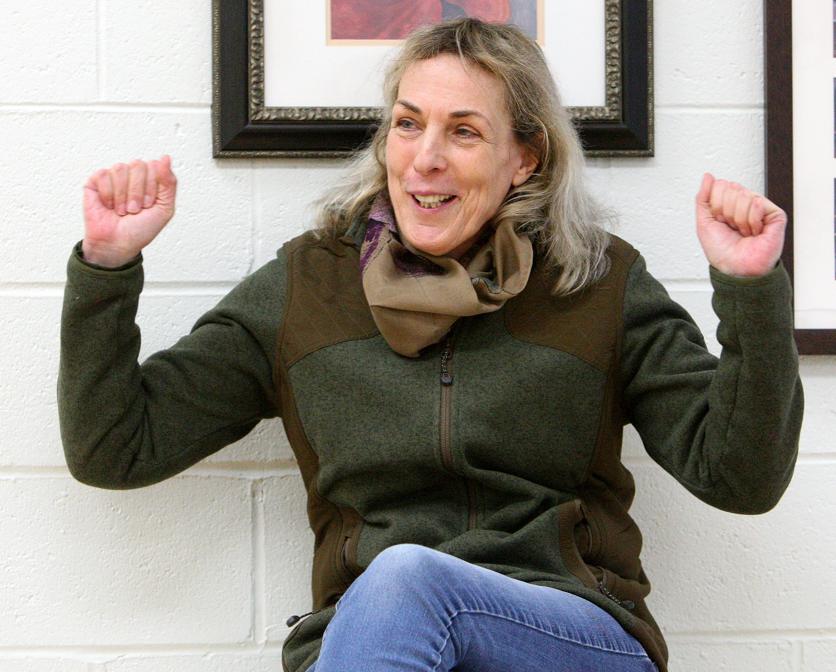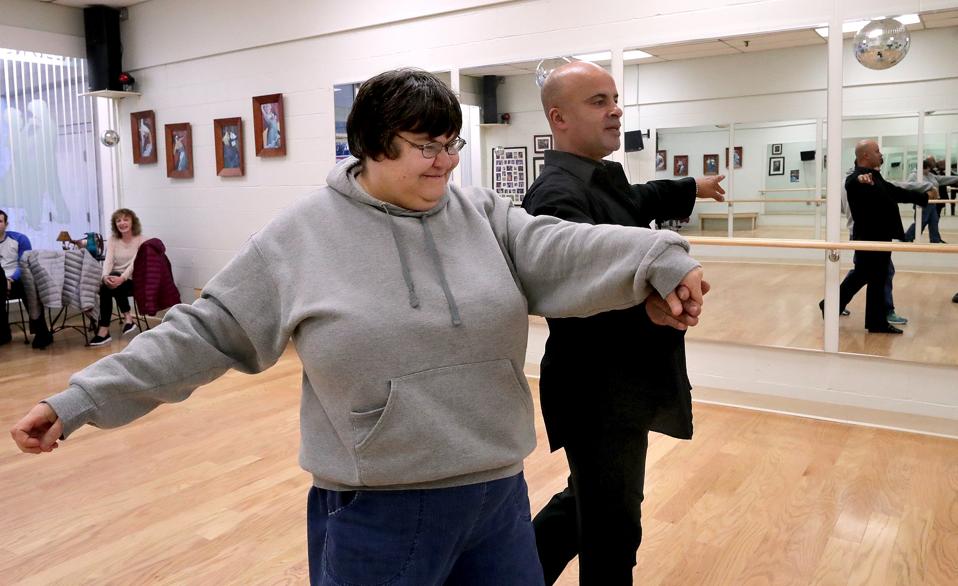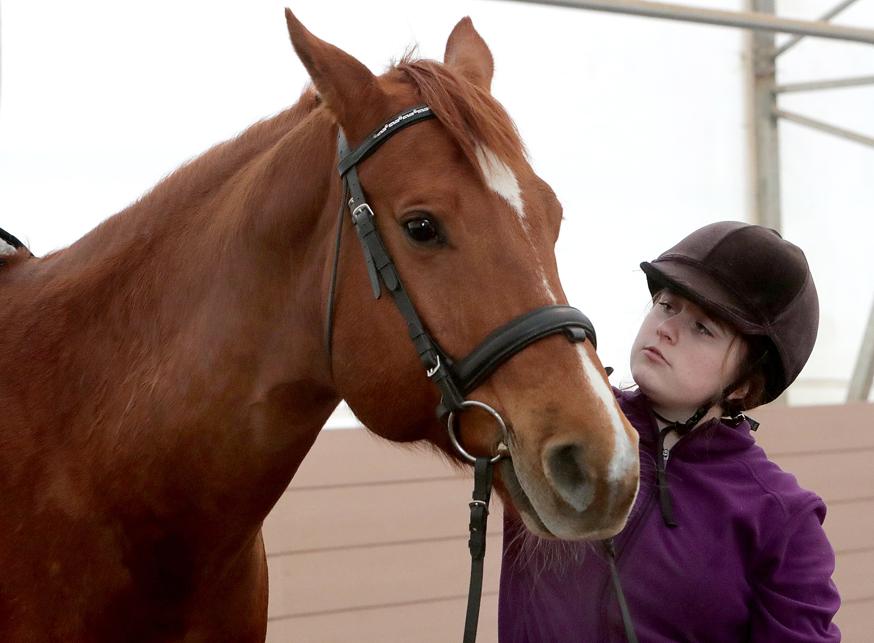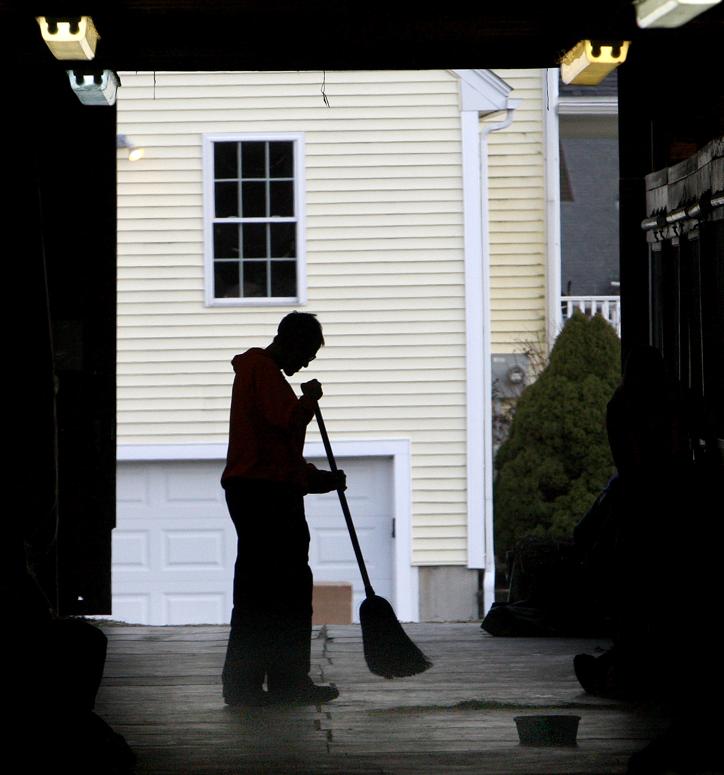




M
egan DiPietro can’t wait to begin her ballroom dancing lesson. She’s eager to show her instructor that she’s mastering the steps.
The studio owner, Cris Plumley, is a native of England who has won several competitive championships. Wearing sweat pants and sneakers, gliding arm in arm with the dapper Plumley as the sound system plays the old standard “Side By Side,’’ DiPietro is clearly thrilled.
“Her face is smiling the whole time she’s here,’’ says Dianne Ferrara, Megan’s aide, watching from the corner with a smile of her own.
Plumley’s Footloose Dance Studioin Salisbury is one of a growing number of Merrimack Valley businesses that have affiliated with the Shared Living Collaborative, an organization providing a progressive range of educational and therapeutic opportunities for people like DiPietro. Based at Gateway Farm in Merrimac, Shared Living serves nearly 150 clients, mostly young adults, all of them with disabilities: autism, cerebral palsy, fragile X syndrome. Many have multiple diagnoses.
The Shared Living community represents people who are often rendered invisible, says founder Daniela Morse. Historically, they’ve been institutionalized or cared for at home by aging parents.
To Morse, however, the folks who make up the Shared Living community aren’t much different from those in any other community. They deserve to be visible.
“Anybody who has the desire should be able to live a life like any other,’’ she says. Under Morse’s inventive leadership, the staff at Shared Living is creating a model that could transform the way communities care for people with disabilities as they enter adulthood.
Shared Living provides critical support and opportunities for young people who have “aged out’’ of educational services, says Michael Weiner, treasurer of the Boston-based Federation for Children with Special Needs.
“The proverbial ‘It takes a village’ to raise, and support, a child with special needs is an apt description,’’ says Weiner. Morse “is an amazing woman doing admirable and important work.’’
It’s a big idea, though one with small beginnings. About a decade ago, after Morse and her husband, Tom,were foster parents for several young people with disabilities, she opened a day center in a room above her garage. She began pairing people who might have been destined for group homes with providers willing to offer a room in their own homes.
When Gateway horse farm became available, she bought it. Clients were put to work caring for the horses, earning minimum wage. There is no middle management at Shared Living; administrators and occupational therapists take a hands-on approach, meeting the needs of the community and shoveling stalls. It’s a cost-effective operation that secures funding from a broad array of revenue streams, from state health agencies to private donors.
Shared Living now manages various facilities for vocational training, from the café kitchen in Merrimac, where clients learn to prepare meals by cooking for the community each weeknight, to farm properties in neighboring towns, where young people learn to tend crops and care for the animals. There’s a new day care for dogs, and Morse has plans to buy a laundromat and a car wash.
Two years ago, Morse bought Wheeler Brook Farm in Georgetown, expanding the farm stand to include a sanctuary for several unusual breeds of animals: belted Galloway cows, mammoth donkeys, and Dartmoor ponies. Her son, Tad, manages the farm after serving for a season under the wing of previous owner Bob Morehouse, who died in late 2015. Tad Morse maintains a crew of young men from the Shared Living community who have embraced life on the farm, his mother says.
Such work assignments help members of the community forge identities that might have otherwise eluded them, says Morse, a native of Germany who retains a hint of her accent. But she’s perhaps most proud of another piece of the Shared Living puzzle: the social activities that the group’s staff and volunteers host for their clients, three times each week.
Some clients, such as Megan DiPietro, take ballroom dancing. Some go bowling. Some opt to play games in a rec room next to a pizza parlor in a Merrimac strip mall. There also are regular “mixers.’’
That kind of socializing is critical, says Morse. “People are social beings. These guys have emotions, feelings, and crushes like anybody else.’’
For those more comfortable in small groups or by themselves, there are options, too. On one recent afternoon, a young woman named Sophie Hays-Nowak took a private riding lesson in the arena behind the Merrimac stables. Her horse is named Gromit, after the loyal, silent dog in the “Wallace & Gromit’’ animated series. Except for Gromit’s occasional whinnying, it was hushed and peaceful in the ring, just as Sophie likes it.
Much as you wouldn’t approach a horse by running at it, Morse says, her community members — many of whom have suffered traumatic experiences on top of their disabilities — need patient, gentle care.
“There’s nothing more dysfunctional than 12 kids with social skills issues sitting in a circle and talking about it,’’ she says.
“We try to normalize all our therapeutic activities.’’
Until last summer, Morse had been too busy to pursue any kind of recognition for the work she and her staff have been doing. Shared Living has never lacked for clients, and the director is not given to self-promotion.
In August, Rolling Stone published “Luke’s Best Chance: One Man’s Fight for His Autistic Son,’’ the story of reporter Paul Solotaroff’s teen son, who was born with fragile X syndrome, a genetic disorder that affects brain development. The article was largely devoted to Solotaroff’s discovery of the Shared Living Collaborative, his wish that his son was in a similar place, and his advocacy for the widespread adoption of Morse’s model.
“I think it’s the future of special needs care in all sorts of domains,’’ says Solotaroff, on the phone from his home in New York.
Since the story ran, Shared Living has been deluged with requests from families frustrated by more traditional options, and from caregivers hoping — as Solotaroff is — to create similar services in their own states. With budget deficits looming and the future of Medicaid uncertain, he says, the reduced costs of Morse’s innovations are significant. Solotaroff’s research found the annual average is $80,000 for room and board with a provider — the Shared Living model — compared with $120,000 or more for a bed in a group home in Massachusetts.
But it’s the improved quality of life for people like his son, he says, that will have real, long-lasting benefits for the community at large.
James Sullivan can be reached at jamesgsullivan@gmail.com.



